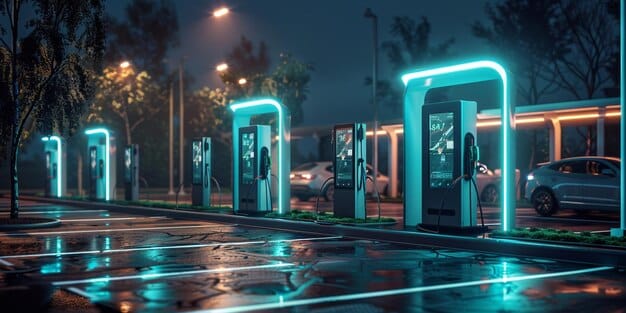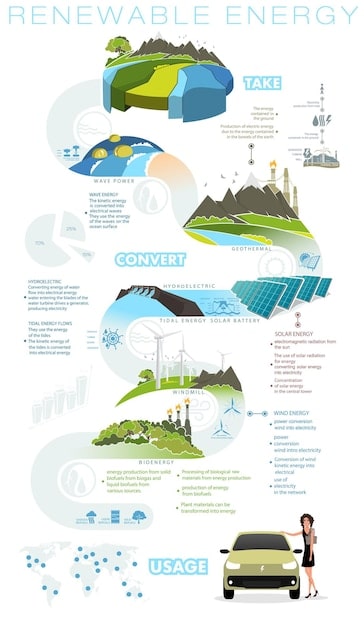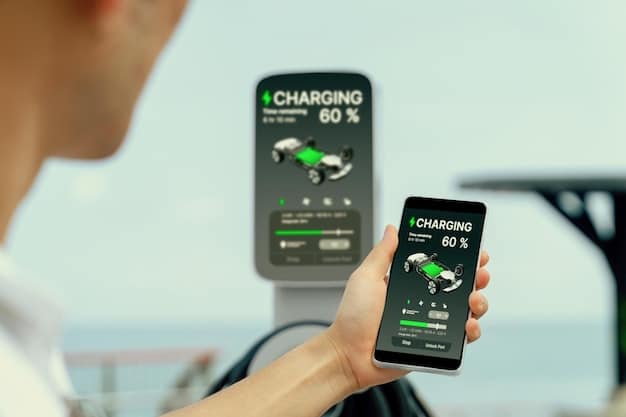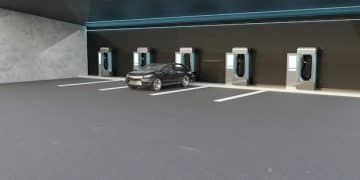Electric Vehicle Grid Integration: Smart Charging for a Stable US Grid

Electric vehicle grid integration utilizes smart charging technology to balance energy demand, stabilize the US power grid, and reduce energy costs by optimizing charging schedules and leveraging renewable energy sources.
As electric vehicles (EVs) become increasingly prevalent, the integration of these vehicles into the power grid presents both opportunities and challenges. Electric vehicle grid integration, particularly through smart charging technology, holds the key to not only stabilizing the US power grid but also to significantly reducing energy costs for consumers and utilities alike.
Understanding electric vehicle grid integration
Electric vehicle grid integration refers to the process of connecting EVs to the electrical grid in a way that allows for two-way communication and energy flow. This integration is crucial for managing the increased demand on the grid due to EV charging and for leveraging the potential of EVs as energy storage devices.
The importance of grid integration
Without proper grid integration, widespread EV adoption could strain the existing power infrastructure, leading to blackouts and increased energy costs. However, with smart integration, EVs can actually enhance grid stability and efficiency.
Two-way communication
Grid integration enables utilities to communicate with EVs and adjust charging schedules in response to grid conditions. This two-way communication allows for demand response programs and the utilization of EVs as distributed energy resources.

- Improved grid stability: By managing charging loads, grid integration helps prevent overloads and ensures a reliable power supply.
- Reduced energy costs: Smart charging can take advantage of off-peak rates and renewable energy sources, lowering the cost of electricity.
- Enhanced renewable energy integration: EVs can store excess renewable energy, making it available when needed and reducing curtailment.
Ultimately, understanding the fundamentals of electric vehicle grid integration is essential for realizing the full potential of EVs and creating a sustainable energy future.
How smart charging technology works
Smart charging technology is the backbone of electric vehicle grid integration. It enables intelligent control over EV charging, allowing for optimized energy consumption and grid support.
Defining smart charging
Smart charging refers to EV charging systems that can adjust the charging rate or timing based on signals from the grid or the vehicle owner’s preferences. These systems use data and communication technologies to optimize charging.
Key components of smart charging
Smart charging systems typically consist of several key components, including smart chargers, communication protocols, and grid management systems.
- Smart chargers: These chargers are equipped with sensors and communication interfaces that enable them to interact with the grid and the vehicle.
- Communication protocols: Protocols like Open Charge Point Protocol (OCPP) and OpenADR facilitate communication between chargers, vehicles, and grid operators.
- Grid management systems: These systems collect data from chargers and vehicles to optimize charging schedules and manage grid loads.
Benefits of smart charging
Smart charging offers numerous benefits for both EV owners and the grid. It can lower charging costs, reduce grid stress, and support the integration of renewable energy sources.
Smart charging technology is not just about plugging in and charging; it’s about intelligently managing energy to benefit both consumers and the energy infrastructure, paving the way for a more sustainable and efficient future.

Stabilizing the US power grid
One of the most significant benefits of electric vehicle grid integration is its potential to stabilize the US power grid. The increasing adoption of EVs presents both challenges and opportunities for grid operators.
Addressing grid instability
The uncoordinated charging of EVs can create significant demand peaks, potentially leading to grid instability and blackouts. Smart charging can mitigate these risks by shifting charging loads to off-peak hours.
Demand response programs
Demand response programs incentivize EV owners to reduce or shift their charging during peak demand periods. These programs can help utilities manage grid loads and avoid costly infrastructure upgrades.
Vehicle-to-grid (V2G) technology
V2G technology allows EVs to not only draw power from the grid but also to send power back to the grid. This bidirectional energy flow can provide valuable grid services, such as frequency regulation and voltage support.
By actively participating in the energy ecosystem, EVs can become valuable assets for grid stabilization, turning potential challenges into opportunities for a more reliable and resilient power infrastructure.
Reducing energy costs with smart charging
Beyond grid stabilization, electric vehicle grid integration can also lead to significant energy cost savings for EV owners and utilities.
Time-of-use (TOU) rates
TOU rates charge different prices for electricity depending on the time of day. EV owners can take advantage of these rates by charging their vehicles during off-peak hours when electricity is cheaper.
Incentives and rebates
Many utilities and government agencies offer incentives and rebates for EV owners who participate in smart charging programs. These incentives can further reduce the cost of EV ownership.
Optimizing charging schedules
Smart charging systems can automatically optimize charging schedules based on TOU rates, renewable energy availability, and the EV owner’s needs. This ensures that EVs are charged at the lowest possible cost.
Through strategic energy management, EV owners can see considerable reductions in their electricity bills, making electric vehicles an increasingly attractive option for budget-conscious consumers.
The role of renewable energy
The integration of electric vehicles with renewable energy sources is a critical component of a sustainable energy future. EVs can play a key role in utilizing and storing excess renewable energy.
Storing excess renewable energy
Renewable energy sources like solar and wind are intermittent, meaning that their output varies depending on weather conditions. EVs can store excess renewable energy during periods of high production, making it available when needed.
Reducing curtailment
Curtailment refers to the practice of reducing renewable energy production when it exceeds grid demand. EVs can help reduce curtailment by absorbing excess energy and storing it for later use.
Integrating EVs with solar and wind
By integrating EVs with solar and wind energy systems, we can create a more reliable and sustainable energy grid. This integration can also reduce our reliance on fossil fuels.
The synergy between electric vehicles and renewable energy is driving a cleaner, more sustainable energy landscape, where EVs are not just consumers of electricity, but active participants in a renewable-powered ecosystem.
Challenges and future trends
While electric vehicle grid integration offers many benefits, there are also challenges that need to be addressed. As technology advances, new trends are expected to shape the future of EV grid integration.
Addressing cybersecurity risks
As EVs become more connected to the grid, cybersecurity risks become a greater concern. Protecting EV charging systems from cyberattacks is crucial for maintaining grid stability and protecting consumer data.
Standardization and interoperability
Lack of standardization and interoperability can hinder the widespread adoption of smart charging technology. Developing common standards and protocols is essential for ensuring that EVs and chargers from different manufacturers can communicate effectively.
Advancements in V2G technology
V2G technology is still in its early stages, but it has the potential to revolutionize the way we manage the grid. Future advancements in V2G technology could enable EVs to provide even more valuable grid services.
- Improved battery technology: Advancements in battery technology will increase the energy storage capacity and lifespan of EVs, making them more suitable for V2G applications.
- Smart grid infrastructure: Investments in smart grid infrastructure will improve the reliability and security of EV grid integration.
- Policy support: Government policies and incentives will play a crucial role in driving the adoption of EV grid integration technologies.
The future of electric vehicle grid integration hinges on overcoming challenges and embracing emerging trends, ultimately leading to a more resilient, efficient, and sustainable energy future for all.
| Key Point | Brief Description |
|---|---|
| ⚡ Smart Charging | Optimizes charging based on grid needs and user preferences. |
| 💰 Cost Reduction | Utilizes off-peak rates and incentives to lower energy costs. |
| 🌱 Renewable Energy | Stores excess renewable energy to reduce curtailment. |
| 🛡️ Grid Stability | Helps prevent overloads by shifting charging to off-peak hours. |
FAQ
▼
It’s connecting EVs to the power grid for two-way energy flow, optimizing energy use and stabilizing the grid while reducing strain on the electric infrastructure.
▼
Smart charging uses time-of-use rates and incentives. Charging during off-peak times lowers costs, with systems optimizing based on rates and renewable energy.
▼
V2G allows EVs to send power back to the grid, supporting frequency and voltage regulation. This turns vehicles into mobile energy resources for utilities.
▼
EVs store excess renewable energy from solar and wind sources, making it available when needed. This reduces curtailment and helps avoid the waste of clean energy.
▼
Challenges include cybersecurity risks, standardization issues, and the need for smart grid infrastructure. Addressing these will drive broader adoption and efficiency of integration.
Conclusion
In conclusion, electric vehicle grid integration through smart charging technology presents a promising solution for stabilizing the US power grid, reducing energy costs, and promoting the integration of renewable energy sources. While challenges remain, ongoing advancements and policy support are paving the way for a more sustainable and efficient energy future.





